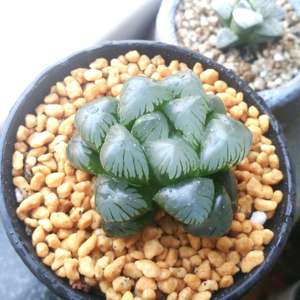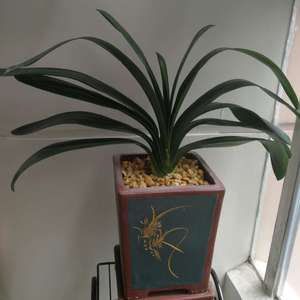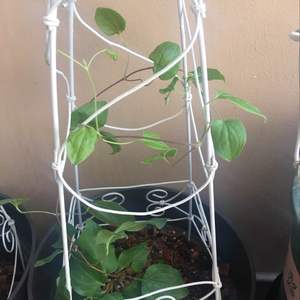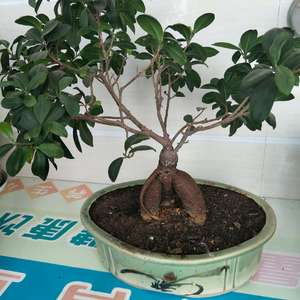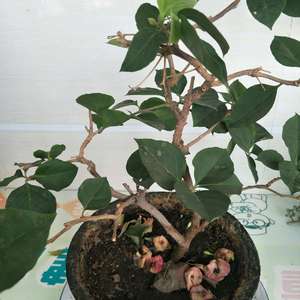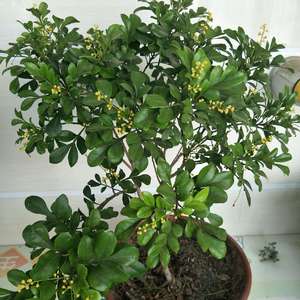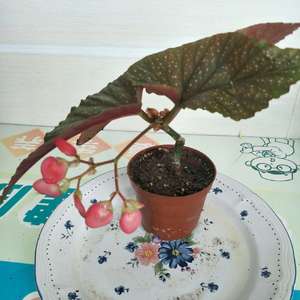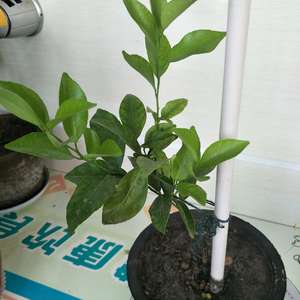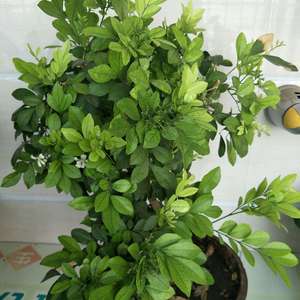文章
Miss Chen
2018年06月26日

Description: This shrub is 1-3' tall, branching occasionally. The woody branches near the base of this shrub have yellowish brown to reddish brown bark that often becomes shredded into white strips or narrow sheets. Young stems are light green, glabrous, and 4-angled. Pairs of opposite primary leaves occur along the young stems. In addition, there are often clusters of smaller secondary leaves near the axils of the opposite primary leaves. These leaves are up to 2" long and 8 mm. (1/3") across; they are linear-oblong to oblanceolate in shape and their margins are entire (toothless) and revolute (rolled downward). The upper leaf surface is bluish green to medium green, glabrous, and sometimes glaucous, while the lower leaf surface is light green, glabrous, and sometimes glaucous. All leaves are sessile or nearly so. The upper stems terminate in corymbs or compound corymbs of 3-7 flowers.
Each flower is about 1–1¼" across, consisting of 5 spreading yellow petals, 5 light green or light yellow sepals, a light yellow pistil with 5 styles (the latter are often united), and numerous conspicuous stamens. The petals are broadly oblong or obovate in shape, while the sepals are lanceolate; the petals are about twice the length of the sepals. The filaments of the stamens are light yellow, while the anthers are medium yellow or golden yellow. The pedicels of the flowers are up to ¾" long, light green, and glabrous. The blooming period occurs from mid-summer to late summer, lasting about 1 month. Afterwards, the flowers are replaced by seed capsules about 8 mm. (1/3") long that are lanceoloid in shape and 5-lobed. The interior of each seed capsule has 5 completely separated cells; there are numerous seeds in each cell. These seeds are dark-colored, narrowly oblongoid, and somewhat flattened. The woody root system is shallow and spreading.

Cultivation: The preference is full sun, wet to moist conditions, and soil containing calcareous sand or limestone. Shallow water is tolerated if it is temporary. This shrub is winter-hardy to Zone 4.
Range & Habitat: Kalm's St. John's Wort occurs in NE Illinois along Lake Michigan, where it is native (see Distribution Map). In Illinois, this shrub is rare and state-listed as 'endangered.' It is endemic to the Great Lakes Region. Habitats include interdunal swales, borders of small sandy ponds, moist to wet sandy meadows, and moist sand flats (pannes). Outside of Illinois, Kalm's St. John's Wort occurs on limestone flats (alvars). This shrub is found in high quality natural areas. It is also cultivated occasionally in gardens because of its showy flowers.

Faunal Associations: Mostly various bees visit the flowers, where they collect pollen. Nectar is not available as a floral reward. Grundel et al. (2011) observed a leaf-cutting bee (Megachile montivaga) and Halictid bees (Augochlorella aurata, Lasioglossum pectorale) visiting the flowers of Kalm's St. John's Wort. Two oligophagous aphids suck the sap of this shrub: Aphis mizzou and Aphis hyperici. The caterpillars of an oligophagous moth, Nedra ramosula (Gray Half-spot), feeds on St. John's Wort species (Hypericum spp.), while the caterpillars of two polyphagous moths, Eupithecia miserulata (Common Pug) and Synchlora aerata (Wavy-lined Emerald), sometimes feed on the flowers (Lagos et al., 2012; Covell, 1984/2005; Wagner, 2005).

Kalm's St. John's Wort is rarely browsed by White-tail Deer. In places where this animal is abundant, this shrub has a tendency to increase because of selective browsing (Bradstreet & Bowles, 2002). The leaves of St. John's Wort species are somewhat toxic to domesticated farm animals, particularly those with white or thin fur. These plants contain a toxin that increases sensitivity to the ultraviolet radiation of sunlight, causing irritation of the skin. Consumption of these plant species can also irritate the gastrointestinal tract of these animals.
Photographic Location: Border of a small sandy pond and a moist sandy meadow near Lake Michigan in NE Illinois.

Comments: Populations of this small showy shrub appear to be increasing in some protected areas of Illinois. Kalm's St. John's Wort can be distinguished from most species of St. John's Wort (Hypericum spp.) by its woody lower branches; most species of St. John's Wort in Illinois are entirely herbaceous. Compared to another shrubby species, Shrubby St. John's Wort (Hypericum prolificum), Kalm's St. John's Wort has more narrow leaves (never exceeding 8 mm. across) and it has 5-celled seed capsules, rather than 3-celled seed capsules. It is similar to another shrubby species that is found in southern Illinois, Five-lobed St. John's Wort (Hypericum lobocarpum). This latter species has cymes with a greater number of flowers (usually exceeding 7 flowers each) and its flowers are smaller in size (about ¾" across).
Each flower is about 1–1¼" across, consisting of 5 spreading yellow petals, 5 light green or light yellow sepals, a light yellow pistil with 5 styles (the latter are often united), and numerous conspicuous stamens. The petals are broadly oblong or obovate in shape, while the sepals are lanceolate; the petals are about twice the length of the sepals. The filaments of the stamens are light yellow, while the anthers are medium yellow or golden yellow. The pedicels of the flowers are up to ¾" long, light green, and glabrous. The blooming period occurs from mid-summer to late summer, lasting about 1 month. Afterwards, the flowers are replaced by seed capsules about 8 mm. (1/3") long that are lanceoloid in shape and 5-lobed. The interior of each seed capsule has 5 completely separated cells; there are numerous seeds in each cell. These seeds are dark-colored, narrowly oblongoid, and somewhat flattened. The woody root system is shallow and spreading.

Cultivation: The preference is full sun, wet to moist conditions, and soil containing calcareous sand or limestone. Shallow water is tolerated if it is temporary. This shrub is winter-hardy to Zone 4.
Range & Habitat: Kalm's St. John's Wort occurs in NE Illinois along Lake Michigan, where it is native (see Distribution Map). In Illinois, this shrub is rare and state-listed as 'endangered.' It is endemic to the Great Lakes Region. Habitats include interdunal swales, borders of small sandy ponds, moist to wet sandy meadows, and moist sand flats (pannes). Outside of Illinois, Kalm's St. John's Wort occurs on limestone flats (alvars). This shrub is found in high quality natural areas. It is also cultivated occasionally in gardens because of its showy flowers.

Faunal Associations: Mostly various bees visit the flowers, where they collect pollen. Nectar is not available as a floral reward. Grundel et al. (2011) observed a leaf-cutting bee (Megachile montivaga) and Halictid bees (Augochlorella aurata, Lasioglossum pectorale) visiting the flowers of Kalm's St. John's Wort. Two oligophagous aphids suck the sap of this shrub: Aphis mizzou and Aphis hyperici. The caterpillars of an oligophagous moth, Nedra ramosula (Gray Half-spot), feeds on St. John's Wort species (Hypericum spp.), while the caterpillars of two polyphagous moths, Eupithecia miserulata (Common Pug) and Synchlora aerata (Wavy-lined Emerald), sometimes feed on the flowers (Lagos et al., 2012; Covell, 1984/2005; Wagner, 2005).

Kalm's St. John's Wort is rarely browsed by White-tail Deer. In places where this animal is abundant, this shrub has a tendency to increase because of selective browsing (Bradstreet & Bowles, 2002). The leaves of St. John's Wort species are somewhat toxic to domesticated farm animals, particularly those with white or thin fur. These plants contain a toxin that increases sensitivity to the ultraviolet radiation of sunlight, causing irritation of the skin. Consumption of these plant species can also irritate the gastrointestinal tract of these animals.
Photographic Location: Border of a small sandy pond and a moist sandy meadow near Lake Michigan in NE Illinois.

Comments: Populations of this small showy shrub appear to be increasing in some protected areas of Illinois. Kalm's St. John's Wort can be distinguished from most species of St. John's Wort (Hypericum spp.) by its woody lower branches; most species of St. John's Wort in Illinois are entirely herbaceous. Compared to another shrubby species, Shrubby St. John's Wort (Hypericum prolificum), Kalm's St. John's Wort has more narrow leaves (never exceeding 8 mm. across) and it has 5-celled seed capsules, rather than 3-celled seed capsules. It is similar to another shrubby species that is found in southern Illinois, Five-lobed St. John's Wort (Hypericum lobocarpum). This latter species has cymes with a greater number of flowers (usually exceeding 7 flowers each) and its flowers are smaller in size (about ¾" across).
0
0
文章
Miss Chen
2018年06月25日

Description: This herbaceous perennial wildflower is about 1-2' tall. Alternate compound leaves occur primarily along the lower half of each hairy stem. These leaves are odd-pinnate; they are up to 8" long and 2" across. The lower leaves have 5-7 leaflets, while the sessile upper leaves have 3 leaflets. The terminal leaflet is much larger than the lateral leaflets. The leaflets are coarsely serrated, slightly hairy, rough-textured, and medium green; the terminal leaflet is sometimes divided into 3 lobes. In addition to these leaflets, the lower leaves have tiny secondary leaflets that are inserted between the lateral leaflets.
The upper stems terminate in nodding cymes of flowers. The branches of each cyme are dark purple and very hairy. Each flower is ¾–1" across, consisting of 5 dull red to pale purple petals, 5 dark purple sepals, numerous stamens with yellow anthers, and numerous pistils in the center. Sometimes the inner sides of the petals are pale yellow; regardless of color, they are conspicuously veined. The hairy sepals are ovate in shape; they are about as long as the petals. Between each pair of sepals, there is a linear bract that is dark purple and hairy. The blooming period occurs from late spring to mid-summer and lasts about 1-2 months. Each pistil is replaced by a flattened achene with a long persistent style; the style is hooked toward its tip and often pubescent. The root system is fibrous and rhizomatous. Dense clumps of plants are often formed from the rhizomes.
Cultivation: The preference is partial to full sun, wet to moist conditions, and cool to mild summer temperatures. Various kinds of soil are tolerated.

Range & Habitat: Water Avens is restricted to northern Illinois, where it is rare and native (see Distribution Map). Because this species has not been observed in natural areas of the state for several decades, it may be extirpated because of destruction or degradation of habitat. Water Avens has a circumboreal distribution in North America, Europe, and Asia; northern Illinois lies at its southern range limit. Habitats include White Cedar fens (in Kane County), bogs, marshes, and soggy meadows. This species is sometimes cultivated in gardens.
Faunal Associations: According to Mueller (1873/1883), the flowers produce both nectar and pollen; they are pollinated primarily by bumblebees. Mueller also observed honeybees, long-beaked Syrphid flies (Rhingia sp.), and Sap beetles (Nitulidae) visiting the flowers for nectar or pollen. Because the achenes have persistent styles with hooked or jointed tips, it is possible that they are distributed by birds or mammals.
Photographic Location: A flower garden at the University of Illinois Arboretum in Urbana, Illinois.
Comments: This is one of the more showy species in the genus. Other Geum spp. (Avens) have smaller flowers that are white or yellow. An exception is Geum triflorum (Prairie Smoke), which has nodding red to purple flowers. Unlike Water Avens, the petals of Prairie Smoke are mostly hidden by the sepals. The achenes of Prairie Smoke have long plumose styles that are distributed by the wind. In contrast, the achenes of Water Avens have styles that are jointed or hooked; they are probably distributed by animals, as noted above. Prairie Smoke typically occurs in dry gravelly prairies, while Water Avens is found in various wetland habitats. Another common name of Geum rivale is Purple Avens.
The upper stems terminate in nodding cymes of flowers. The branches of each cyme are dark purple and very hairy. Each flower is ¾–1" across, consisting of 5 dull red to pale purple petals, 5 dark purple sepals, numerous stamens with yellow anthers, and numerous pistils in the center. Sometimes the inner sides of the petals are pale yellow; regardless of color, they are conspicuously veined. The hairy sepals are ovate in shape; they are about as long as the petals. Between each pair of sepals, there is a linear bract that is dark purple and hairy. The blooming period occurs from late spring to mid-summer and lasts about 1-2 months. Each pistil is replaced by a flattened achene with a long persistent style; the style is hooked toward its tip and often pubescent. The root system is fibrous and rhizomatous. Dense clumps of plants are often formed from the rhizomes.
Cultivation: The preference is partial to full sun, wet to moist conditions, and cool to mild summer temperatures. Various kinds of soil are tolerated.

Range & Habitat: Water Avens is restricted to northern Illinois, where it is rare and native (see Distribution Map). Because this species has not been observed in natural areas of the state for several decades, it may be extirpated because of destruction or degradation of habitat. Water Avens has a circumboreal distribution in North America, Europe, and Asia; northern Illinois lies at its southern range limit. Habitats include White Cedar fens (in Kane County), bogs, marshes, and soggy meadows. This species is sometimes cultivated in gardens.
Faunal Associations: According to Mueller (1873/1883), the flowers produce both nectar and pollen; they are pollinated primarily by bumblebees. Mueller also observed honeybees, long-beaked Syrphid flies (Rhingia sp.), and Sap beetles (Nitulidae) visiting the flowers for nectar or pollen. Because the achenes have persistent styles with hooked or jointed tips, it is possible that they are distributed by birds or mammals.
Photographic Location: A flower garden at the University of Illinois Arboretum in Urbana, Illinois.
Comments: This is one of the more showy species in the genus. Other Geum spp. (Avens) have smaller flowers that are white or yellow. An exception is Geum triflorum (Prairie Smoke), which has nodding red to purple flowers. Unlike Water Avens, the petals of Prairie Smoke are mostly hidden by the sepals. The achenes of Prairie Smoke have long plumose styles that are distributed by the wind. In contrast, the achenes of Water Avens have styles that are jointed or hooked; they are probably distributed by animals, as noted above. Prairie Smoke typically occurs in dry gravelly prairies, while Water Avens is found in various wetland habitats. Another common name of Geum rivale is Purple Avens.
0
0
文章
Miss Chen
2018年06月25日

Description: This herbaceous wildflower is a biennial about 1-3' tall. During the first year, it forms a low rosette of leaves, while during the second year it bolts, forming flowering stalks. Small second-year plants branch sparingly, if at all, while robust second-year plants branch readily, especially above. The stems are light green, yellowish green, or reddish green; they are terete and glabrous. Pairs of opposite leaves occur along these stems. Individual leaves are 1-2½" long and ¼-1" across; they are ovate, lanceolate, or narrowly lanceolate in shape and smooth along their margins. Each leaf is rounded at the base, where it is sessile or clasps the stem. Both the lower and upper surfaces of the leaves are yellowish green to medium green and glabrous. The leaves have prominent central veins and a slightly succulent texture.

Upper stems terminate with individual flowers on long peduncles (up to 8" in length). Each flower is 1½-2½" long, consisting of a broad tubular corolla with spreading 4 lobes that are rounded and fringed, 4 lanceolate to ovate sepals that are about one-half the length of the corolla, 4 inserted stamens, and a pistil with a short style. The corolla varies in color from medium blue to deep dark blue. The sepals are light green to reddish green, glabrous, and keeled; 2 sepals are shorter than the other 2 sepals. The shorter sepals have membranous margins. The upright peduncles are light green to reddish green and glabrous; they are terete and sometimes slightly ribbed (striated). The blooming period occurs from early to mid-fall and lasts about 1½-2 months. The flowers are diurnal, opening up on sunny days, while remaining closed on cloudy days and during the night. There is no noticeable floral scent. The flowersStems & Opposite Leaves are replaced by elongated seed capsules. Individual capsules divide into 2 parts to release the numerous tiny seeds within. To some extent, they are distributed by wind and water. The seed surface is minutely bumpy. The root system consists of a shallow branching taproot. This wildflower reproduces by reseeding itself.
Cultivation: The preference is full or partial sun, somewhat wet to moist conditions, and calcareous sandy soil with a neutral pH. Insect pests and disease organisms rarely bother this wildflower. Robust plants can sprawl if they are not supported by adjacent vegetation.
Range & Habitat: Fringed Gentian is a rare native wildflower that is found in NE Illinois, while in the rest of the state it is absent (see Distribution Map). While populations have declined from habitat destruction, Fringed Gentian is not yet listed as 'endangered' or 'threatened' within the state. Habitats include wet to moist sand prairies, sandy pannes near Lake Michigan, edges of sandy sloughs and sandy swales, fens, open wooded swamps, wooded ravines, roadside ditches, and open damp areas along sandy trails. Fringed Gentian is usually associated with high quality wetlands where the original flora is still intact, although it has a tendency to colonize open disturbed areas both in and around these habitats.
Faunal Associations: Information about floral-faunal relationships for this wildflower is scant. The nectar and pollen of the flowers attract primarily bumblebees. Costelloe (1988) observed the following bumblebees visiting the flowers of Fringed Gentian in Ohio: Bombus fervidus, Bombus impatiens, Bombus perplexus, and Bombus vagans. Apparently, the bitter foliage is rarely bothered by insects and mammalian herbivores.
Photographic Location: Edge of a wet sandy meadow along a trail at the Indiana Dunes National Lakeshore in NW Indiana.

Comments: The flowers have an unearthly beauty that is positively stunning; Fringed Gentian ranks among the most attractive of all wildflowers within Illinois. Another similar species in this genus is Gentianopsis procera (Lesser Fringed Gentian). This latter species is a petite version of Fringed Gentian: it is usually shorter with smaller flowers and leaves. The flowers of Lesser Fringed Gentian have corolla lobes that are less deeply fringed, and its leaves are more narrow (becoming linear-lanceolate to nearly linear underneath the flowers). Lesser Fringed Gentian is even less common than Fringed Gentian, preferring similar to slightly wetter habitats. Another common name of Gentianopsis crinita is Greater Fringed Gentian; a scientific synonym of this species is Gentiana crinita.

Upper stems terminate with individual flowers on long peduncles (up to 8" in length). Each flower is 1½-2½" long, consisting of a broad tubular corolla with spreading 4 lobes that are rounded and fringed, 4 lanceolate to ovate sepals that are about one-half the length of the corolla, 4 inserted stamens, and a pistil with a short style. The corolla varies in color from medium blue to deep dark blue. The sepals are light green to reddish green, glabrous, and keeled; 2 sepals are shorter than the other 2 sepals. The shorter sepals have membranous margins. The upright peduncles are light green to reddish green and glabrous; they are terete and sometimes slightly ribbed (striated). The blooming period occurs from early to mid-fall and lasts about 1½-2 months. The flowers are diurnal, opening up on sunny days, while remaining closed on cloudy days and during the night. There is no noticeable floral scent. The flowersStems & Opposite Leaves are replaced by elongated seed capsules. Individual capsules divide into 2 parts to release the numerous tiny seeds within. To some extent, they are distributed by wind and water. The seed surface is minutely bumpy. The root system consists of a shallow branching taproot. This wildflower reproduces by reseeding itself.
Cultivation: The preference is full or partial sun, somewhat wet to moist conditions, and calcareous sandy soil with a neutral pH. Insect pests and disease organisms rarely bother this wildflower. Robust plants can sprawl if they are not supported by adjacent vegetation.
Range & Habitat: Fringed Gentian is a rare native wildflower that is found in NE Illinois, while in the rest of the state it is absent (see Distribution Map). While populations have declined from habitat destruction, Fringed Gentian is not yet listed as 'endangered' or 'threatened' within the state. Habitats include wet to moist sand prairies, sandy pannes near Lake Michigan, edges of sandy sloughs and sandy swales, fens, open wooded swamps, wooded ravines, roadside ditches, and open damp areas along sandy trails. Fringed Gentian is usually associated with high quality wetlands where the original flora is still intact, although it has a tendency to colonize open disturbed areas both in and around these habitats.
Faunal Associations: Information about floral-faunal relationships for this wildflower is scant. The nectar and pollen of the flowers attract primarily bumblebees. Costelloe (1988) observed the following bumblebees visiting the flowers of Fringed Gentian in Ohio: Bombus fervidus, Bombus impatiens, Bombus perplexus, and Bombus vagans. Apparently, the bitter foliage is rarely bothered by insects and mammalian herbivores.
Photographic Location: Edge of a wet sandy meadow along a trail at the Indiana Dunes National Lakeshore in NW Indiana.

Comments: The flowers have an unearthly beauty that is positively stunning; Fringed Gentian ranks among the most attractive of all wildflowers within Illinois. Another similar species in this genus is Gentianopsis procera (Lesser Fringed Gentian). This latter species is a petite version of Fringed Gentian: it is usually shorter with smaller flowers and leaves. The flowers of Lesser Fringed Gentian have corolla lobes that are less deeply fringed, and its leaves are more narrow (becoming linear-lanceolate to nearly linear underneath the flowers). Lesser Fringed Gentian is even less common than Fringed Gentian, preferring similar to slightly wetter habitats. Another common name of Gentianopsis crinita is Greater Fringed Gentian; a scientific synonym of this species is Gentiana crinita.
0
0
文章
Miss Chen
2018年06月25日

1.Aeonium
The majority of us can't grow Aeoniums year round, in the garden. Don't let that stop you from enjoying them, though. Although they have the familiar rosettes of Hens and Chicks, these quirky succulents are so waxy and shiny, they almost look artificial. In warm climates, they can grow into shrubs. Just imagine coming across a Hens and Chicks at eye level.
As with many of the succulents listed here, Aeonium makes a good houseplant. You can give it a summer vacation outdoors and enjoy it indoors during the winter, it's prime growing season. (USDA Hardiness Zones 9 - 11)
2.Agave
You may be familiar with the giant Agave Americana, with its dangerous, serrated leaves. It's impressive, but not suited to most gardens. There are better choices among the dozens of Agave species. There are even some that can tolerate freezing temperatures.
3.Crassula
With about 350 species in this genus, there's a lot of variety. Jade plants, Crassula ovata, (syn. C. argentea and C. portulaca) are probably the most familiar, but there are also the stacked types, Crassula perforata, that look a little like paper chaines. Colors range from deep green to creams and yellows, silvery gray and shade of red.
In frost free climates, jade plants will form small shrubs. There's are now some very pretty variegated varieties available, which need full sun to retain their colors.
The staked varieties lend themselves to use in hanging containers and over walls. You'll love this little Crassula alpestris. The triangular leaves form stacked pinwheels. They are a pinkish-red during the winter, into spring. At the end of summer, you may get spikes of small white. They can handle some shade and like their soil on the dry side.
4.Echeveria
Another succulent that forms flower-like rosettes atop long stalks. Echeveria resembles Hens and Chicks and can be very ornamental. The leaves are more delicate than they appear and can be easily injured in garden beds. They are perfect for containers and hypertufa.
5.Euphorbia
This is a large genus with a great deal of variety. Not all Euphorbia are succulents but they do all have a milky sap that can be irritating. Be careful about rubbing your eyes after collecting seeds.
The majority of us can't grow Aeoniums year round, in the garden. Don't let that stop you from enjoying them, though. Although they have the familiar rosettes of Hens and Chicks, these quirky succulents are so waxy and shiny, they almost look artificial. In warm climates, they can grow into shrubs. Just imagine coming across a Hens and Chicks at eye level.
As with many of the succulents listed here, Aeonium makes a good houseplant. You can give it a summer vacation outdoors and enjoy it indoors during the winter, it's prime growing season. (USDA Hardiness Zones 9 - 11)
2.Agave
You may be familiar with the giant Agave Americana, with its dangerous, serrated leaves. It's impressive, but not suited to most gardens. There are better choices among the dozens of Agave species. There are even some that can tolerate freezing temperatures.
3.Crassula
With about 350 species in this genus, there's a lot of variety. Jade plants, Crassula ovata, (syn. C. argentea and C. portulaca) are probably the most familiar, but there are also the stacked types, Crassula perforata, that look a little like paper chaines. Colors range from deep green to creams and yellows, silvery gray and shade of red.
In frost free climates, jade plants will form small shrubs. There's are now some very pretty variegated varieties available, which need full sun to retain their colors.
The staked varieties lend themselves to use in hanging containers and over walls. You'll love this little Crassula alpestris. The triangular leaves form stacked pinwheels. They are a pinkish-red during the winter, into spring. At the end of summer, you may get spikes of small white. They can handle some shade and like their soil on the dry side.
4.Echeveria
Another succulent that forms flower-like rosettes atop long stalks. Echeveria resembles Hens and Chicks and can be very ornamental. The leaves are more delicate than they appear and can be easily injured in garden beds. They are perfect for containers and hypertufa.
5.Euphorbia
This is a large genus with a great deal of variety. Not all Euphorbia are succulents but they do all have a milky sap that can be irritating. Be careful about rubbing your eyes after collecting seeds.
0
1



